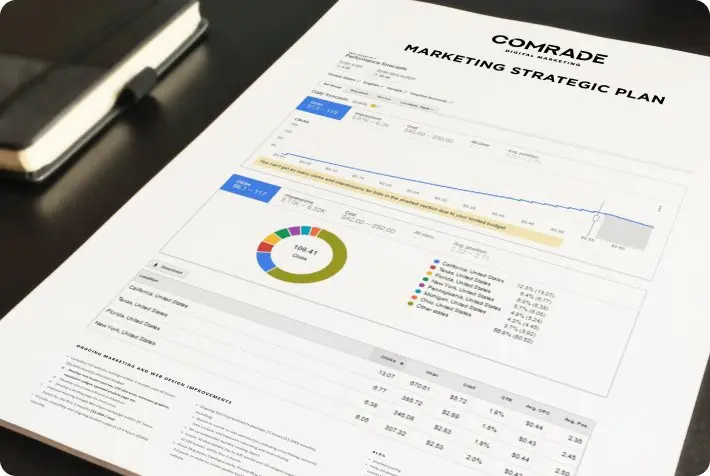When it comes to professional outreach and visibility, LinkedIn is the key. As this platform has continued to grow, it has become clear that ensuring you have a presence on LinkedIn is crucial, especially for lawyers. And it’s not just about having a visible profile for others to view, but utilizing it as a digital marketing strategy. For law firms aiming to attract high-value clients and stand out in a crowded market, LinkedIn offers a powerful platform to showcase expertise, build credibility, and foster valuable connections. Imagine your firm’s profile not just as a digital business card, but as a dynamic marketing tool that continuously works to draw in prospective clients and reinforce your reputation as a thought leader.
From crafting compelling content to leveraging endorsements and recommendations, mastering LinkedIn can transform your firm’s online presence and client acquisition strategy. In this guide, our team at Comrade Digital Marketing will explore actionable strategies to enhance your LinkedIn profile, ensuring it captivates potential clients and establishes your firm as a trusted authority in the legal field. Let’s dive in!

Why Lawyers Should Use LinkedIn
There’s a reason so many businesses, including law firms, are turning to LinkedIn as part of their marketing strategy. This dynamic platform goes beyond job hunting—it’s a game-changer for lawyers aiming to elevate their practice. Whether you’re looking to connect with potential clients or boost your firm’s visibility, LinkedIn provides unmatched opportunities. Learn why leveraging LinkedIn is essential for transforming your professional journey and expanding your client base:
Professional Networking: Connect with peers, potential clients, and industry influencers to expand your professional network.
Client Acquisition: Showcase your expertise and attract new clients through a well-crafted, client-focused profile.
Reputation Building: Build and maintain a strong professional reputation by sharing insightful content and achievements.
Industry Insights: Stay updated on industry trends and competitor activities to stay ahead in your field.
Referral Opportunities: Engage with other legal professionals who can provide referrals or collaborative opportunities.
Brand Visibility: Increase your firm’s visibility and credibility by consistently sharing valuable content and thought leadership.
Recruitment: Attract top legal talent by highlighting your firm’s culture, values, and career opportunities.
Ready to take your legal practice to the next level? Embrace LinkedIn’s potential and watch your professional network expand, your reputation soar, and new clients come knocking. By leveraging these seven powerful reasons, you’ll not only enhance your firm’s visibility but also position yourself as a leading authority in the legal field. Start optimizing your LinkedIn presence today to turn connections into clients.
Comrade Digital Marketing Agency can help you with the above if you’re unsure how to go about it. Schedule a free consultation.
Step-by-Step Instructions for Creating a Profile That Strengthens Your Legal Practice
Your profile is more than just a listing—it’s a powerful tool for growth. Learn how to enhance it with our 15-step guide, designed to help you showcase your skills and attract more clients. Read on for expert tips and start building a profile that makes a difference.
Step 1: Define Your Target Audience

To effectively attract clients through LinkedIn, it’s crucial to start by defining your target audience. Understanding who you want to reach will guide your content and profile strategy, making sure your efforts align with the needs of potential clients. Consider factors like industry, business size, and geographic location. Tailoring your profile to address the specific needs and concerns of these groups can significantly enhance your client attraction efforts.
Identify Industry Focus: Determine which industries or sectors you want to target (e.g., tech startups, real estate, healthcare).
Define Demographic Characteristics: Understand the age, gender, and professional level of your ideal clients.
Analyze Geographic Location: Decide if you are targeting local, national, or international clients.
Assess Client Needs: Outline the common legal issues or services these clients might need.
Determine Decision-Makers: Identify who within these organizations makes legal decisions.
By clearly defining your target audience, you can craft a LinkedIn profile that speaks directly to their needs and positions your firm as the solution to their problems. This targeted approach helps in creating content and engagement strategies that resonate with your ideal clients.
Step 2: Craft a Professional Headline
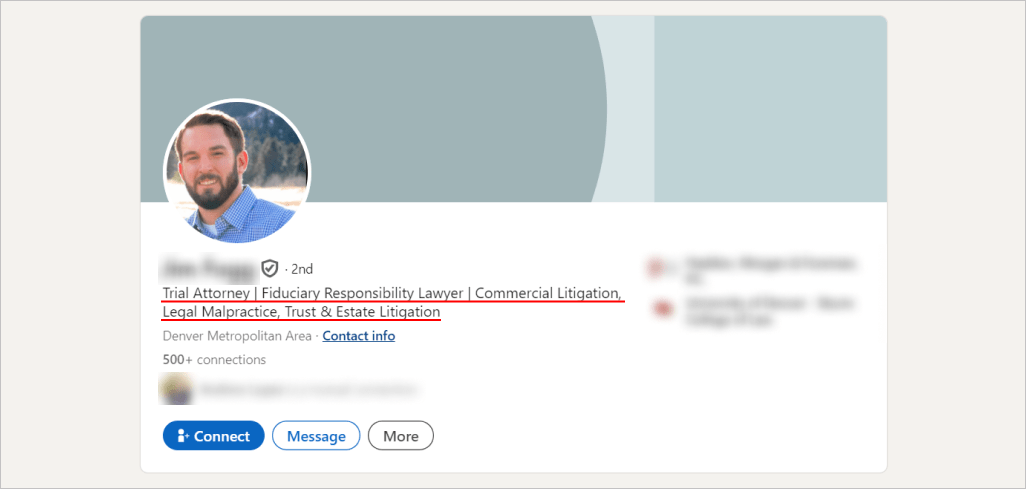
Your LinkedIn headline is one of the first things people see when they visit your profile, so it needs to make a strong impression. A well-crafted headline should succinctly convey your expertise, practice areas, and the value you offer. Instead of just listing your job title, use this space to showcase what makes your firm or you unique in the legal industry.
Include Key Practice Areas: Mention your primary areas of legal expertise (e.g., family law, intellectual property).
Highlight Unique Selling Points: What sets your firm apart? This could be years of experience, notable case results, or specialized knowledge.
Use Relevant Keywords: Incorporate terms that potential clients might use when searching for legal services.
Showcase Your Value Proposition: Explain how your services can solve specific problems or add value to potential clients.
A compelling headline not only captures attention but also encourages visitors to learn more about your services. By clearly presenting your expertise and value, you can attract the right clients who are actively seeking the legal solutions you offer.
The Best LinkedIn Headlines for Lawyers
Crafting an effective LinkedIn headline is crucial for lawyers seeking to make a strong first impression. A compelling headline not only highlights your legal expertise but also conveys your unique value proposition. It should succinctly showcase your specialization and the benefits you bring to clients or employers, using keywords that improve search visibility.
Examples of Effective LinkedIn Headlines for Lawyers:
“Corporate Lawyer Specializing in Mergers & Acquisitions | Helping Businesses Navigate Complex Transactions”
“Criminal Defense Attorney | Protecting Your Rights with Proven Litigation Strategies”
“Family Law Expert | Advocating for Fair and Compassionate Resolutions in Custody and Divorce Cases”
“Employment Lawyer | Championing Workers’ Rights and Ensuring Fair Workplace Practices”
A well-crafted headline sets the tone for your profile, attracting potential clients or employers by clearly communicating your expertise and areas of focus. It’s your chance to stand out in a competitive field and make a memorable impact, so take time to consider what line best represents your firm.
Step 3: Choose a High-Quality Profile Picture
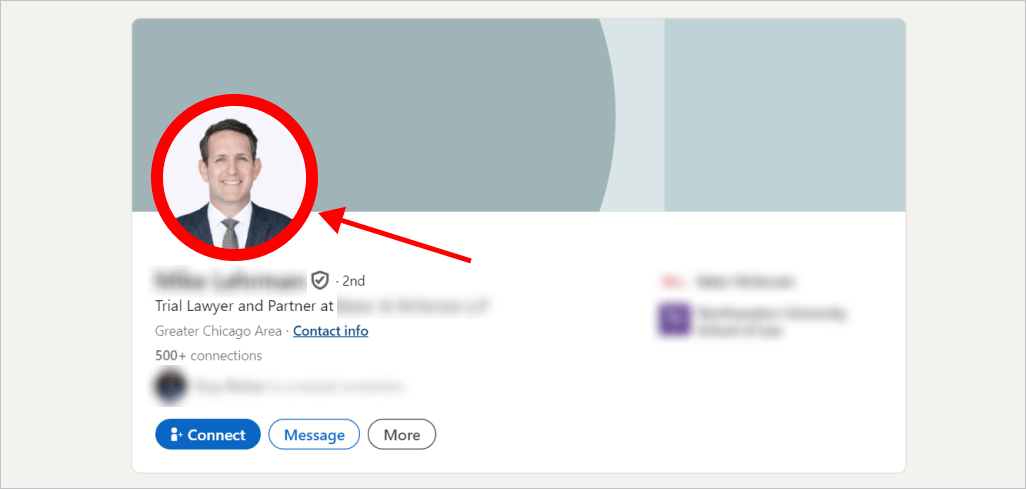
A high-quality profile picture is essential for making a positive first impression on LinkedIn. Your profile picture should project professionalism and approachability, helping to build trust with potential clients. Opt for a headshot that reflects your role as a lawyer, dressed in professional attire and featuring a friendly, confident expression.
Use Professional Photography: Invest in a professional photographer to ensure high resolution and proper lighting.
Dress Appropriately: Wear business attire that aligns with your firm’s image and the expectations of your target audience.
Maintain a Neutral Background: Choose a simple background that does not distract from your face.
Express Confidence and Approachability: Smile naturally and present yourself as approachable yet professional.
Keep It Updated: Ensure your profile picture is current and accurately represents your appearance.
A polished profile picture not only enhances your credibility but also helps in forming a favorable first impression. It conveys professionalism and helps potential clients feel more comfortable reaching out to you.
Step 4: Write a Compelling Summary
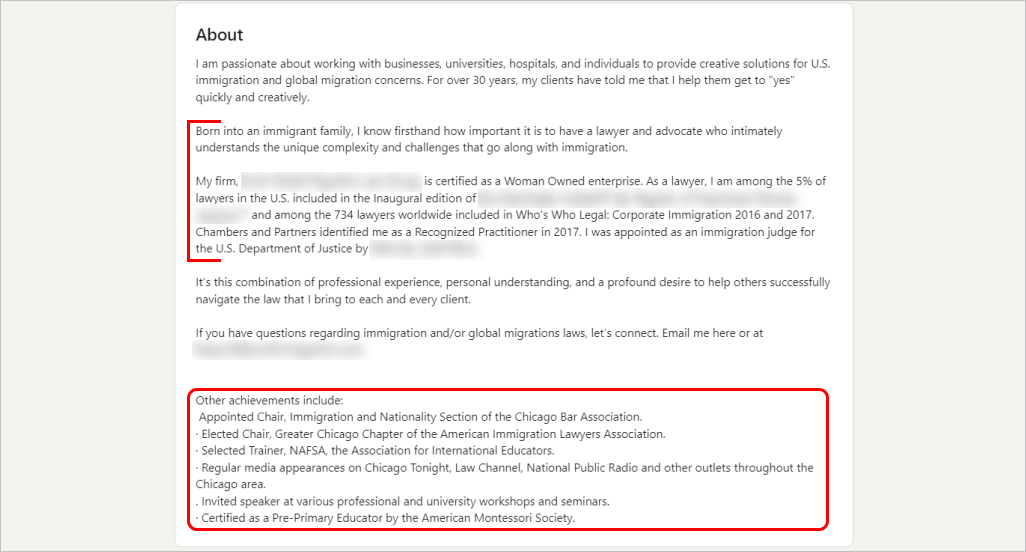
Your LinkedIn summary is a critical section for capturing the essence of your professional identity and your firm’s values. This section should provide a narrative that highlights your experience, skills, and the unique value you offer to clients. A compelling summary can engage visitors and encourage them to connect with you or inquire about your services.
Start with a Strong Opening: Begin with a compelling statement that captures attention and outlines your core value proposition.rr
Detail Your Experience: Summarize your professional background, including key roles and notable achievements.
Highlight Your Practice Areas: Clearly mention the specific areas of law you specialize in and your expertise.
Showcase Your Unique Qualities: Explain what sets you apart from other legal professionals.
Include a Call to Action: Invite potential clients to connect, schedule a consultation, or visit your firm’s website for more information.
A well-crafted summary provides a snapshot of your professional persona and can significantly influence how potential clients perceive your services. By presenting a clear, engaging narrative, you make it easier for clients to understand your expertise and approach.
Step 5: Highlight Your Key Practice Areas

Effectively highlighting your key practice areas is essential for attracting the right clients to your LinkedIn profile. Clearly defining and showcasing the specific legal services you offer helps potential clients quickly understand how you can meet their needs. Focus on the areas where you have the most experience and success, as these will be most relevant to your target audience.
Detail Specific Practice Areas: List each area of law you specialize in (e.g., estate planning, corporate law, personal injury).
Include Sub-Areas or Niches: If applicable, mention any sub-specialties or niche practices within your main areas.
Describe Your Expertise: Provide brief descriptions of your experience and successes in each practice area.
Use Relevant Keywords: Incorporate terms and phrases that potential clients might use when searching for legal services.
Highlight Achievements and Results: Mention notable cases or outcomes that demonstrate your capability in each practice area.
By clearly outlining your practice areas, you make it easier for potential clients to find and connect with you based on their specific legal needs. This targeted approach helps to attract clients who are looking for the exact expertise you provide.
Step 6: Showcase Your Experience and Achievements

Highlighting your professional experience and achievements is a must when looking to establish credibility and demonstrate your expertise. Potential clients and connections use this information to assess your qualifications and track record. Focus on showcasing your most significant roles and accomplishments to build a compelling case for your services.
List Relevant Positions: Include detailed descriptions of your previous roles, including job titles and responsibilities.
Highlight Major Achievements: Mention any awards, recognitions, or significant cases you’ve worked on.
Quantify Your Success: Whenever possible, use metrics or specific outcomes to illustrate your impact (e.g., “secured a $5 million settlement”).
Include Leadership Roles: Highlight any leadership or significant contributions within your firm or professional associations.
Showcase Publications or Speaking Engagements: Mention any legal articles you’ve published or conferences where you’ve spoken.
Showcasing your experience and achievements builds trust and positions you as a knowledgeable and accomplished professional. This helps potential clients feel confident in your ability to handle their legal matters effectively.
Step 7: Add Relevant Certifications and Licenses

Adding your relevant certifications and licenses to your LinkedIn profile enhances your credibility and showcases your qualifications. These credentials provide tangible proof of your expertise and adherence to professional standards. Make sure to list any certifications or licenses that are pertinent to your practice areas or that demonstrate specialized knowledge.
List Legal Certifications: Include any certifications relevant to your practice (e.g., Certified Mediator, Certified Estate Planner).
Show Professional Licenses: Display licenses from relevant jurisdictions where you are authorized to practice law.
Include Bar Association Memberships: Mention memberships in state or national bar associations, as these add to your professional standing.
Detail Additional Qualifications: Add any specialized training or courses that contribute to your expertise.
By clearly displaying your certifications and licenses, you provide potential clients with reassurance of your qualifications and commitment to maintaining high professional standards. This transparency helps in building trust and establishing your authority in your field.
Step 8: Request and Display Client Recommendations
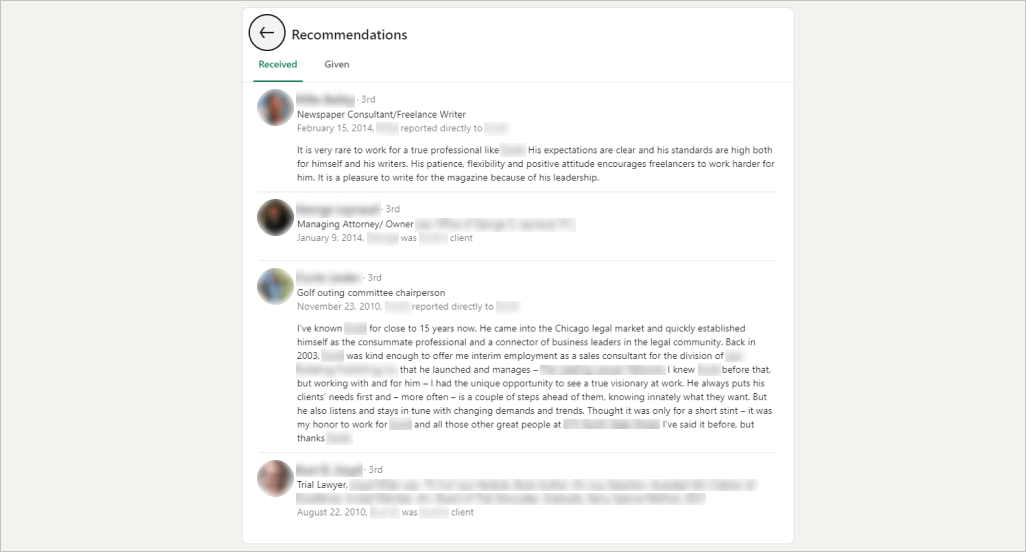
Client recommendations are powerful endorsements that can significantly impact your LinkedIn profile’s effectiveness. Positive testimonials from satisfied clients provide social proof of your skills and services. Actively seeking and showcasing these recommendations can enhance your reputation and attract new clients.
Request Recommendations: Reach out to past and current clients, asking them to provide a LinkedIn recommendation.
Guide Clients on What to Mention: Suggest they highlight specific aspects of your service, such as your expertise, professionalism, or results.
Display Recommendations Prominently: Ensure that client recommendations are visible on your profile and that they are from reputable sources.
Update Regularly: Continuously seek new recommendations to keep your profile current and reflective of your recent work.
Respond to Recommendations: Acknowledge and thank clients for their recommendations to show appreciation and engagement.
Displaying client recommendations not only validates your skills but also enhances your profile’s credibility. Positive feedback from clients can be a decisive factor for potential clients considering your legal services. This not only shows your successful track record but also helps potential clients feel more comfortable when turning to you for their legal needs.
Step 9: Publish Articles and Insights

Publishing articles and insights on LinkedIn is a strategic way to showcase your legal expertise and establish yourself as a thought leader in your field. Regularly sharing valuable content not only engages your network but also attracts potential clients who are seeking knowledgeable and up-to-date legal advice.
Write Informative Articles: Create content on relevant legal topics, recent legal developments, or common client issues.
Share Case Studies or Legal Analysis: Provide in-depth analysis of notable cases or legal trends to demonstrate your expertise.
Offer Practical Tips: Share actionable advice that potential clients can use, such as tips for handling legal issues or understanding complex legal concepts.
Post Regular Updates: Maintain a consistent posting schedule to keep your audience engaged and informed.
Publishing relevant articles and insights not only demonstrates your expertise but also enhances your visibility on LinkedIn. By providing valuable information, you position yourself as a trusted resource and attract clients interested in your knowledge and services. In addition, by sharing content, you can improve the chances that others re-share it, further broadening your reach.
Step 10: Optimize Your Profile for Keywords

Optimizing your LinkedIn profile for keywords is crucial for ensuring that potential clients can find you when searching for legal services. By strategically incorporating relevant keywords, you improve your profile’s visibility in LinkedIn searches and enhance your chances of being discovered by those seeking your expertise.
Identify Relevant Keywords: Research terms that potential clients might use to find legal services in your practice areas (e.g., “business lawyer,” “divorce attorney”).
Incorporate Keywords in Your Headline: Use key terms that reflect your primary areas of expertise.
Include Keywords in Your Summary: Mention important keywords naturally within your summary to improve search relevance.
Optimize Experience Descriptions: Use keywords in the descriptions of your roles and achievements to highlight your expertise.
Update Skills and Endorsements: Add relevant skills to your profile and seek endorsements from connections to reinforce your keyword optimization.
By optimizing your profile for keywords, you increase your visibility to potential clients searching for legal services. This strategic approach helps attract the right audience and improves your profile’s effectiveness in connecting with clients who need your legal expertise.
Step 11: Add Media to Showcase Your Work
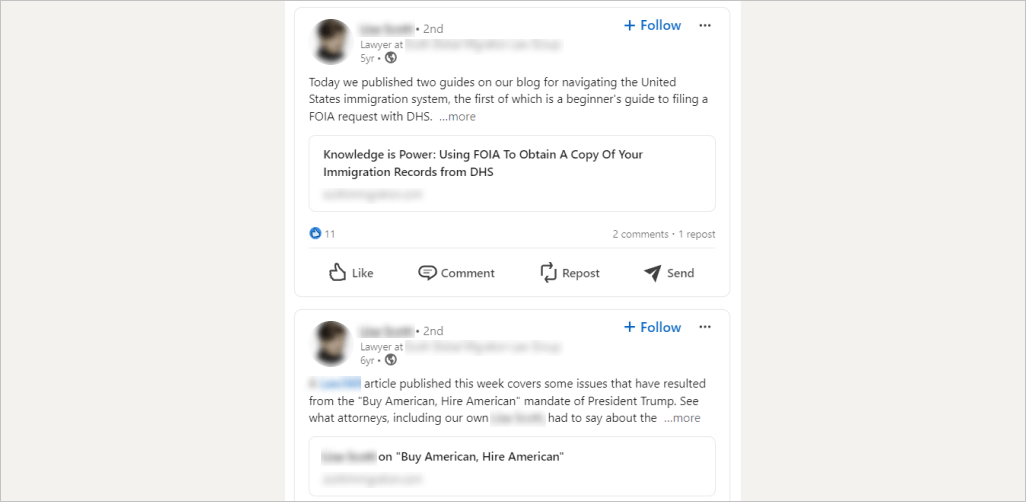
Adding media to your LinkedIn profile is an effective way to visually showcase your work and achievements. This can include presentations, case studies, videos, or other relevant content that highlights your expertise and successes. Media elements make your profile more engaging and provide tangible evidence of your capabilities.
Upload Case Studies: Share documents or presentations detailing notable cases or projects you’ve worked on.
Include Client Testimonials: Post video or written testimonials from satisfied clients to add credibility.
Showcase Legal Publications: Add links or documents of articles or papers you’ve authored in legal journals or magazines.
Add Professional Photos or Graphics: Use high-quality images to illustrate your work or firm’s achievements.
Incorporating media into your profile not only makes it more dynamic but also provides potential clients with clear examples of your work and accomplishments. This multimedia approach helps to capture attention and demonstrate your expertise in a more impactful way.
Step 12: Update Your Contact Information

Keeping your contact information up-to-date is an absolute must to ensure that potential clients and professional connections can easily reach you. Make sure your contact details are accurate and accessible to facilitate communication and inquiries.
Verify Email Address: Ensure your professional email address is correct and regularly checked.
Update Phone Number: If applicable, provide a direct phone number where clients can contact you.
Include Office Address: If relevant, add your firm’s office address to help local clients find you.
Add Website Links: Include links to your firm’s website or any relevant legal blogs or resources you manage.
Enable Messaging: Make sure LinkedIn messaging is enabled so that connections can reach out directly through the platform.
By keeping your contact information current, you make it easy for potential clients to get in touch with you. This accessibility is crucial for converting interest into actual consultations or client engagements.
Step 13: Create a Custom LinkedIn URL

Creating a custom LinkedIn URL is a simple yet effective way to enhance your professional branding and make your profile more accessible. A personalized URL not only looks more professional but also makes it easier to share your LinkedIn profile with potential clients and connections.
Access Profile Settings: Navigate to the LinkedIn settings to customize your public profile URL.
Choose a Professional URL: Opt for a URL that includes your name or your firm’s name, such as linkedin.com/in/yourname.
Avoid Special Characters: Use only letters and numbers to keep the URL clean and easy to remember.
Update Your Resume and Business Cards: Reflect your custom LinkedIn URL on your resume, business cards, and other professional materials.
Promote Your URL: Share your custom URL on your firm’s website, email signatures, and social media to increase visibility.
A custom LinkedIn URL improves your professional appearance while also enhancing the ease with which clients can find and connect with you. It simplifies the process of sharing your LinkedIn profile and helps in building a cohesive online presence.
Step 14: Join and Participate in Legal Groups
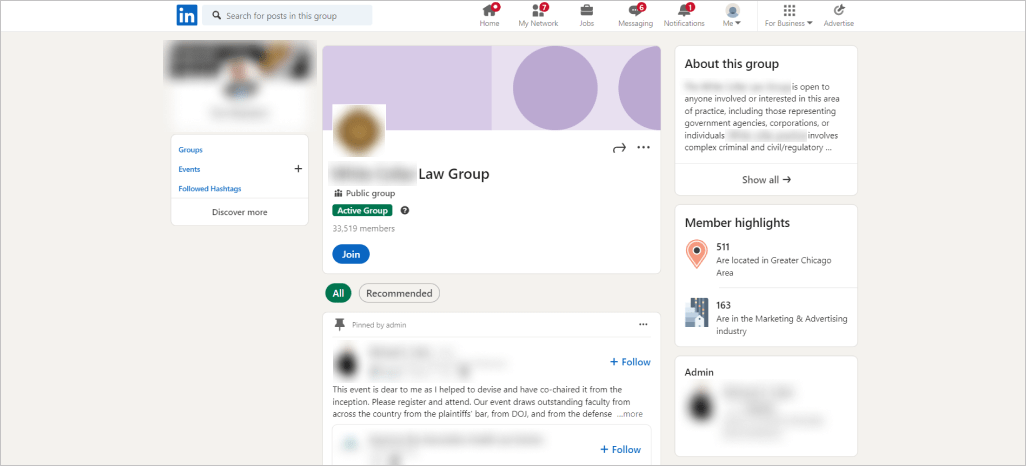
Joining and participating in legal groups on LinkedIn is a valuable strategy for expanding your network and establishing your expertise. These groups offer a platform to connect with other legal professionals, share insights, and engage in discussions on relevant legal topics.
Find Relevant Groups: Search for LinkedIn groups related to your practice areas, legal specialties, or professional interests.
Join Active Groups: Choose groups with active discussions and a substantial number of members to maximize your engagement.
Participate in Discussions: Contribute to group discussions by sharing your knowledge, answering questions, and providing valuable insights.
Share Your Content: Post articles or updates that are relevant to the group’s interests, demonstrating your expertise and adding value.
Network with Members: Connect with fellow group members who share your professional interests or could benefit from your services.
Active participation in legal groups enhances your visibility within the legal community and positions you as a thought leader. It also provides opportunities for networking and staying current with industry trends and developments.
Step 15: Leverage LinkedIn Analytics for Insights

Leveraging LinkedIn analytics provides valuable insights into how your profile is performing and how you can optimize it for better results. Analyzing metrics such as profile views, engagement rates, and connection growth helps you understand what works and where improvements can be made.
Monitor Profile Views: Track the number of views your profile receives and identify trends or spikes.
Analyze Engagement Metrics: Review how often your posts are liked, shared, or commented on to gauge content effectiveness.
Assess Connection Growth: Evaluate how your network is expanding and identify key connections or areas for growth.
Review Search Appearances: Check how often your profile appears in search results and adjust keywords or content as needed.
Track Content Performance: Measure the success of articles and posts to understand what topics resonate with your audience.
Using LinkedIn analytics helps you make data-driven decisions to enhance your profile’s impact. By regularly reviewing these insights, you can refine your strategy, improve engagement, and better attract potential clients.
Conclusion
Creating a LinkedIn profile that attracts clients involves more than just listing your services. In fact, standing out on this platform requires a strategic approach to branding, content, and networking. As you implement the steps discussed, from optimizing your profile to actively engaging with your audience, you’ll start to see the tangible benefits of a well-executed LinkedIn strategy. A professionally crafted profile can position your firm as a leader in your field and a trusted advisor to potential clients, elevating your law firm to other professionals on LinkedIn.
Ready to elevate your LinkedIn game and attract a steady stream of clients? At Comrade Digital Marketing, we specialize in developing bespoke LinkedIn strategies that align with your firm’s unique strengths and goals. Let us help you turn your LinkedIn profile into a powerful client magnet. Contact us today to discover how our expertise can drive your firm’s growth and visibility on this crucial platform. Let’s work together to achieve LinkedIn success and beyond!
Frequently Asked Questions
-
How should I handle negative comments or reviews on LinkedIn?
Address negative comments or reviews professionally and promptly. Acknowledge the issue raised, apologize if necessary, and offer to resolve the matter offline or in private messages. Avoid engaging in arguments or getting defensive. A well-handled response from a law firm can demonstrate your commitment to client satisfaction and professionalism, turning a negative experience into a positive opportunity for growth.
-
How often should I post content on LinkedIn?
Aim to post on LinkedIn 2-3 times per week to keep your law firm’s profile active and relevant. Regular updates about intellectual property law, complex legal issues, and case studies will enhance your LinkedIn lawyer profile and attract engagement from LinkedIn users. Consistent posting, combined with a professional headshot photo LinkedIn, and strategic social media marketing, helps establish your firm as a leading authority.
-
What should I avoid posting on LinkedIn?
Avoid posting content that could lead to legal issues or require legal counsel, such as overly promotional or controversial material. Be cautious about joining LinkedIn groups or sharing personal opinions that could be seen as unprofessional or disrespectful. Always ensure your posts align with your law firm’s values and expertise, prioritizing valuable insights over self-promotion or irrelevant content.
About the Author


